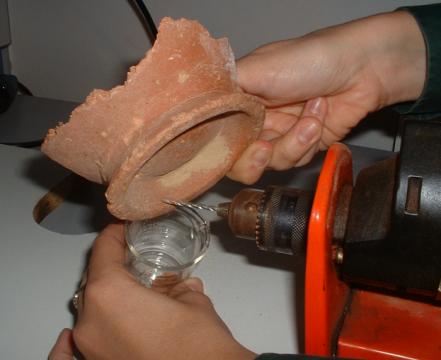Dating and characterization of ancient materials. Materials science and cultural heritage
The Archeometry Lab

Since 1980 our activity focused on the application of scientific techniques to archaeology, geology and cultural heritage, in particular in the field of absolute dating and characterization of archaeological materials.
Thermoluminescence (TL) and optically stimulated luminescence (OSL) are used to determine the event of ceramics firing and sediment deposition respectively. Other available techniques are dendrochronology and radiocarbon. Recently, we started investigating the new Rehydroxylation (RHX) dating technique, based on the water gain of pottery after firing in kiln.
Our research also deals with non-invasive spectroscopic methods, mainly performed using portable instruments, to study polychrome artefacts of various kind (paintings on boards, enamels, decorated ceramics, metal artifacts ...).
The laboratory is member of CUDaM (Centro Universitario Datazioni Università di Milano Bicocca) and of BIPAC (Centro Ricerche per il Patrimonio Storico, Artistico e Culturale).
The laboratory is associate member of EURADOS (European Radiation Dosimetry Group, Working Group 10), of MODIS (Mortar Dating Intercomparison Study) and of the RHX International Research group to validate and study the rehydroxylation dating technique.
Since 2012 the laboratory is a first level hub in the CH_NET E-RIHS Italian cultural heritage network.
Main topics
- Fundamental studies of the low temperature TL peak in quartz and of the Pre-dose effect
- Optical properties of mosaic glasses
- Charge transfer phenomena in quartz and feldspars luminescence
- New procedures for the extraction of collagen for 14C dating
- New procedures for identifying and selecting the anthropogenic calcite in archaeological mortars.
- TL and OSL dating of mortars, Surface dating
- Study and characterization of natural materials for accident dosimetry
- Rehydroxylation (RHX) dating of archaeological pottery
- Joined use of non-invasive methods (EDXRF, FORS, Raman) for the characterization of Renaissance pigments.
- Development of portable systems for in situ XRF analysis
Research Team
Prof. Anna Galli
Prof. Marco Martini
Research Lab
U5 Building, 1st Floor, Room 1011-1016-1108
Facilities
- Home- made TL system based on photon counting technique with EMI 9235QB photomultiplier tube coupled to Corning BG12 blue filters
- Risø TL-DA- 20 reader single-grain attachment; blue LEDs (470 ± 30 nm, constant stimulation power 54 mW/cm2) and IR LEDS (830 ± 10 nm, constant stimulation power 360 mW/cm2); photons detection by bialkali photomultiplier tube EMI 9235QB coupled to 7.5mm Hoya U-340 filter (280-380 nm).
- Home- made instrumentation for wavelength resolved thermoluminescence (spectral range 200-800 nm; temperatures range 290-800 K).
- Gravimetric water sorption analyzer Aquadyne DVS2
- Home made graphitization line, home made chemical digestion line, Elementar CHNS analyzer.
- Perkin Elmer ELAN DRC-e ICP-Q- MS with New Wave UP 213 Laser Ablation sampler
- EDXRF spectrometer ARTAX 200 Bruker;
- Dino- Lite Digital Microscope AM4013MZT